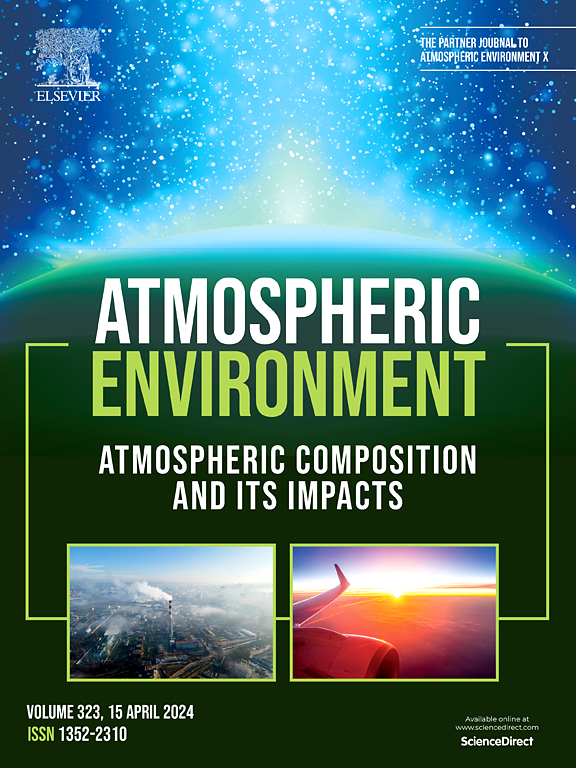Inferring near-surface ozone production regimes: Insights from using satellite retrievals over the contiguous US
IF 4.2
2区 环境科学与生态学
Q2 ENVIRONMENTAL SCIENCES
引用次数: 0
Abstract
Surface ozone regulation policies rely heavily on air quality models, such as CAMx, for guidance. Comparison with observations is crucial to evaluating a model's ability to represent ozone production chemistry. Identifying factors influencing surface ozone formation is complicated because ozone photochemical production rates are non-linearly dependent on concentrations of precursors such as nitrogen oxides (NOx) and volatile organic compounds (VOCs). We compare ozone production regimes (OPRs) identified from satellite observations and model simulations, as defined by the ratio of column formaldehyde to nitrogen dioxide (FNR, HCHO/NO2). We performed CAMx simulations for summer 2016 over the Contiguous United States (CONUS) and compared output against two OMI NO2 and HCHO retrievals. Our analysis spans diurnal and altitudinal variations of OPRs, offering important insights for effective policy formulation. At the time of the OMI overpass oz(∼1:30 p.m. LT), OPR is NOx-limited over most of the CONUS, as determined from OMI column ratios. Analysis of CAMx column ratios shows similar results. In contrast, more regions are VOC-limited when we constrain our ratio to within the Planetary Boundary Layer (PBL). In the morning (∼9 a.m. LT), the CAMx PBL column ratios shift towards VOC-limited regime compared to the afternoon. We highlight areas of the CONUS where satellite measurements of FNR may not be an accurate indicator of near-surface OPRs. Air quality regulations based on satellite observations should consider the diurnal variations of surface OPRs and assess how well their ratios represent near-surface OPR. Our results have implications for interpretation of TEMPO data for policy relevant applications.
推断近地表臭氧产生机制:利用美国连续地区卫星反演的见解
地表臭氧管制政策在很大程度上依赖CAMx等空气质量模型作为指导。与观测值的比较对于评估一个模式代表臭氧生成化学的能力至关重要。确定影响地表臭氧形成的因素是复杂的,因为臭氧光化学生成速率非线性地依赖于氮氧化物(NOx)和挥发性有机化合物(VOCs)等前体的浓度。我们比较了从卫星观测和模式模拟中确定的臭氧产生机制(OPRs),由柱甲醛与二氧化氮的比率(FNR, HCHO/NO2)定义。我们在2016年夏季对美国(CONUS)进行了CAMx模拟,并将输出与两次OMI NO2和HCHO检索进行了比较。我们的分析跨越了opr的日变化和海拔变化,为有效的政策制定提供了重要的见解。在OMI立交桥时间(格林威治标准时间下午1:30),根据OMI柱比确定,大部分CONUS的OPR是受nox限制的。CAMx柱比分析也显示了类似的结果。相比之下,当我们将比值限制在行星边界层(PBL)内时,更多的区域是voc受限的。在上午(~上午9点LT), CAMx PBL柱比与下午相比转向voc限制区。我们强调了CONUS中卫星测量的FNR可能不是近地表opr的准确指标的区域。基于卫星观测的空气质量法规应考虑地表OPR的日变化,并评估其比值代表近地表OPR的程度。我们的结果对政策相关应用的TEMPO数据的解释具有启示意义。
本文章由计算机程序翻译,如有差异,请以英文原文为准。
求助全文
约1分钟内获得全文
求助全文
来源期刊

Atmospheric Environment
环境科学-环境科学
CiteScore
9.40
自引率
8.00%
发文量
458
审稿时长
53 days
期刊介绍:
Atmospheric Environment has an open access mirror journal Atmospheric Environment: X, sharing the same aims and scope, editorial team, submission system and rigorous peer review.
Atmospheric Environment is the international journal for scientists in different disciplines related to atmospheric composition and its impacts. The journal publishes scientific articles with atmospheric relevance of emissions and depositions of gaseous and particulate compounds, chemical processes and physical effects in the atmosphere, as well as impacts of the changing atmospheric composition on human health, air quality, climate change, and ecosystems.
 求助内容:
求助内容: 应助结果提醒方式:
应助结果提醒方式:


